| Pages:
1
2 |
Pyro
International Hazard
    
Posts: 1305
Registered: 6-4-2012
Location: Gent, Belgium
Member Is Offline
Mood: No Mood
|
|
An illustrated guide on the preparation of white phosphorus (P4) from red phosphorus (P)
By Pyro
16 August 2013, 3:48AM
-Introduction
White phosphorus is an extremely reactive and hard to get allotrope of phosphorus while red phosphorus is more readily available from chemical
suppliers or matchboxes.
In this article I will describe one of the ways to make the white allotrope from the red.
the reaction proceeds as follows:
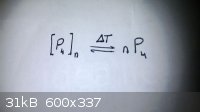
So if red phosphorus is strongly heated the red phosphorus will convert to white phosphorus, but as the double arrow indicates, this reaction is
reversible so it is important to cool down the newly formed white phosphorus as soon as possible.
This article will consist of three parts:
the first on the bending of a regular test tube to make a suitable retort, the second on the preparation of white phosphorus from red phosphorus and
the third on the purification of the crude white phosphorus to analytical grade white phosphorus
-Reagents
H2SO4
P
K2Cr2O7
dH2O
(the amounts used here are not crucial)
-apparatus
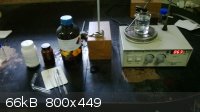
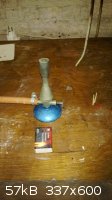
-Hotplate
-beakers
-clamps and stands
-stirring rod
-spatula
-tweezers
-test tube (soda lime or 3.3 borosilicate)
-thermometer (ideally built into the hotplate)
-bunsen burner/teclu burner
-matches
-For the first and second part rubber gloves are not recommended as you are working with fire and in that case rubber will make burns worse, but in
the third they are highly recommended! When I was finished mine smelt seriously like P4.
-All the appropriate safety equipment. A lab coat is essential, followed by cotton trousers, closed shoes and goggles or a faceshield
-Part I---Bending a regular test tube to make a suitable retort
I started with a box of 16mmx160mm soda lime test tubes. I prefer soda lime as it is a lot easier to bend. Many people prefer 3.3 borosilicate because
it's less prone to cracking due to thermal stress but it's more expensive and If you heat it properly there should be no danger at all of it cracking
you will need to light the burner and turn it to the maximum setting, then take a test tube by each end and hold the middle in the upper part of the
flame, rotate it for about 1-2mins. You should see the flame turning yellow where it's touching the glass, now gently pull the two ends apart while
bending, this will ensure a smooth bend with no kinks that can collect P4.
the finished test tube should be bent between 90* and 100*, the closer to 90* the better. It should look something like this:
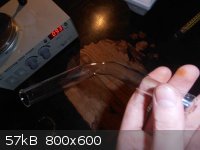
but ideally it would be closer to 90*.
-Part II---preparation of crude white phosphorus from red phosphorus
With the spatula, put red phosphorus into the bent test tube. put enough in to get a 2-3cm deep layer on the bottom, then place it in a clamp and
suspend it above a beaker of warm water (+-50*C) so that the mouth is as far under water as possible.
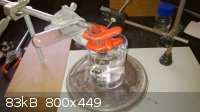 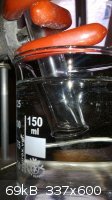
I find it unnecessary to mix SiO2 with the red phosphorus, I have never had problems with bumping.
Now start the burner, you want a gentle flame. I set it so there is a little yellow tip on it so its not too hot. Now hold the base in your hand and
tilt it towards the tube, heat the open end first and work back to the closed end (e.g. from left to right on the above picture).
As soon as the glass gets hot enough the P will ignite. It is nothing spectacular, just a barely visible yellow green flame which goes out quickly.
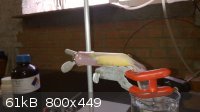 In this picture the P is on fire, it is nothing to worry about In this picture the P is on fire, it is nothing to worry about
now continue heating, the red phosphorus will turn to P4 and you will see the vapors coming up and condensing in the curved part. The glass there is
hot enough to keep it molten so once enough has built up it will run down the glass and drip into the beaker
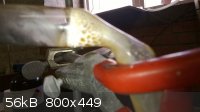 Here the drops of P4 are condensing and dripping down Here the drops of P4 are condensing and dripping down
Warning!:If you overheat it bubbles of P4 vapor will come out of the test tube, catching fire the effects range from a big bang to a
gentle fizzing sound but will not occur unless you are careless
The P4 that collects in the beaker will be anything from dark red (almost black) to lemon yellow depending on how carefully you heat.
cleanup (retort) Now that you have your P4 you need to safely remove it from the water without it catching fire.
I have two ways.
#1:wait for the retort to cool completely and then get a stopper large enough to block the mouth of the tube, then put in between a pair of tweezers
and insert it into the mouth of the retort, loosen the clamp and remove the retort. Then place it somewhere safe (e.g. concrete, sand,...) and gently
remove the stopper and let it burn, usually it just smokes, but better safe than sorry.
#2: again wait for the retort to cool down completely, then get a pipette and gently start bubbling air into the retort, waiting a few seconds between
bubbles. the P4 will smoke a bit and sometimes catch fire. then remove the clamp from the stand and carry the test tube to the safe spot, holding it
by the end of the clamp
-Part III---Purification of the crude P4
when the P4 is freshly distilled it is usually orange with lots of other junk.
Half fill a pipette with water and then suck in the molten P4 and transfer it to a beaker of dH2O at 50*C. next add 5ml of H2SO4 and then 2 spatulas
of K2Cr2O7 and stir for about 5-10 mins. then transfer the purer P4 to another beaker of 50*C dH2O and stir for about 20 mins. by then it should be
white. If it is then pipette it off to a clean beaker of water, cool it and transfer it to a good bottle.
-results
a bottle of nice pure P4
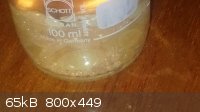
remember to store it in the dark!
-IMPORTANT SAFETY NOTICE!!!
If you wish to try this you have to know a few things about P4:
-White phosphorus is EXTREMELY flammable and toxic
-Red phosphorus is very flammable
-high temperatures are used that can result in severe burns
-Chromium waste is hazardous for the environment
-CrVI is toxic and carcinogenic
-98% H2SO4 is extremely corrosive
-burning P and P4 creates lots of corrosive smoke
-any drops of molten P4 immediately catch fire if exposed to air
-in parts 1&2 NO gloves, molten rubber/plastic is not nice, I speak from experience (molten nylon)
-all cotton clothing, faceshield, closed shoes/boots are very important! also have a respirator nearby. a piece of burning P4 throws smaller bits of
burning P4 around and makes a lot of toxic smoke (I speak from experience here too  ) )
 
you do not want to be anywhere near here
Should an accident occur, remember these things:
-put 1% CuSO4 solution on the affected area, this will give the P4 a brown/black coating, making it easier to clean off any small bits of P4 with
tweezers.
-Remove affected clothing to minimize risk of re ignition
-soak the affected area in a saline solution and keep it moist
-visit a (military) doctor is any symptoms of phosphorus poisoning occur.
from the CDC emergency response card:
| Quote: |
TIME COURSE: Exposure to white phosphorus may cause immediate burns that heal slowly. Systemic toxicity from white phosphorus exposure is classically
divided into 3 phases. The first phase, the gastrointestinal phase, occurs a few minutes to 8 hours following white phosphorus exposure. Shock during
this phase may be severe enough to cause death in 24 to 48 hours. The second phase, the asymptomatic phase, follows the first phase and lasts for 8
hours to 3 days. The third phase, the multi-organ failure and central nervous system injury phase, may begin 4 to 8 days after the second phase
begins, and may end in death.
EFFECTS OF SHORT-TERM (LESS THAN 8-HOURS) EXPOSURE: White phosphorus burns in air and causes severe burns upon contact with skin or eyes. White
phosphorus smoke will also cause eye and respiratory tract irritation. Other initial adverse health effects are primarily due to gastrointestinal
irritation.
EYE EXPOSURE: White phosphorus fumes cause severe irritation and the sensation of a foreign body in the eye. This leads to excessive tear production
(lacrimation), spasmodic blinking (blepharospasm), and increased sensitivity to light (photophobia). White phosphorus particles are caustic and
seriously damaging when in contact with tissues. They cause damage to the cornea, including perforation, inflammation of the interior of the eyeball
(endophthalmitis), and abnormal turning out of the eyelid (ectropion).
INGESTION EXPOSURE: Stage 1: Feeling of warmth or burning pain in the throat and abdomen accompanied by feelings of intense thirst; nausea, vomiting
(emesis), diarrhea, and severe abdominal pain; garlic odor to the breath, vomitus, and feces; vomitus and feces may glow (luminesce) and are capable
of causing burns on contact with skin; death may occur within 24 to 48 hours due to complete cardiovascular collapse.
INHALATION EXPOSURE: Eye and upper respiratory tract irritation are expected. Delayed onset of accumulation of fluid in the lungs (pulmonary edema) is
possible. Whole-body (systemic) effects may also occur. See Ingestion Exposure.
SKIN EXPOSURE: White phosphorus causes severely painful, partial (second degree) to full thickness (third degree) burns, which have a characteristic
yellow color and garlic-like odor. Smoke may be released from the burn site from the continued burning of white phosphorus or the formation of
phosphoric acid. White phosphorus is highly fat soluble, and easily absorbed through the skin, possibly causing whole-body (systemic) effects. See
Ingestion Exposure
|
here are other ways to perform step II:
http://www.versuchschemie.de/topic,5774,-Wei%DFer+Phosphor.h...
http://woelen.homescience.net/science/chem/exps/RedP2WhiteP/...
Credit goes to Endimion17 for the procedure of preparing the P4 from P
[Edited on 21-8-2013 by Pyro]
all above information is intellectual property of Pyro.  |
|
|
Marvin
National Hazard
   
Posts: 995
Registered: 13-10-2002
Member Is Offline
Mood: No Mood
|
|
White phosphorous consists of P4 units, the red has the same units but they are arranged in long chains - it's a polymer of the white.
Distilling breaks the molecule into smaller units, P4 or P2 (if hot enough) in the gas phase and when these condense as
P4 units they do so separately, i.e. in the white unpolymerised state.
Try something like [P4]n as red. Prolonged heating (faster with a catalyst) or exposure to
light polymerises the white. Purple and black can be thought of as more heavily polymerised allotropes with crosslinking.
|
|
|
Pyro
International Hazard
    
Posts: 1305
Registered: 6-4-2012
Location: Gent, Belgium
Member Is Offline
Mood: No Mood
|
|
I don't know if what you are saying is true, do you have any references that support your theory?
as for black or violet phosphorus, I believe that the black coating of the retorts contains at least some. I will add this to the original post once I
have pictures of the retorts...
all above information is intellectual property of Pyro.  |
|
|
Marvin
National Hazard
   
Posts: 995
Registered: 13-10-2002
Member Is Offline
Mood: No Mood
|
|
The Phosphorous page on English Wikipedia has a fair summary of the allotropes but if it's about trusting the source then I suggest you look at an
inorganic undergraduate textbook, pretty much any one should cover this. If you think the dark material might be violet or black, try burning some
and see if it produces the oxide.
If you are bothered about the vapourisation part then I'm not sure I can help with references. This is just basic chemistry. Vapourisation is about
breaking the bonds that keep things liquid or solid - normally weak ones, Van de Waals, Hydrogen bonding. It's why water has a boiling point of 100C
and methane is at -164C even though they are just 2 amus different. When polymers are heated they are too big to boil off intact, they reach
temperatures that cause them to break apart and often useful amounts of monomer can be recovered. That is exactly what is going on here, only with an
element.
|
|
|
Pyro
International Hazard
    
Posts: 1305
Registered: 6-4-2012
Location: Gent, Belgium
Member Is Offline
Mood: No Mood
|
|
I mean, do you have a reference to red phosphorus being [P4]n and not P?
The problem about my theory is that it is stuck in the base of the test tube. it would mean breaking them and lots of tedious work to get even a tiny
amount!
http://avogadro.chem.iastate.edu/MSDS/p-red.htm
http://www.sigmaaldrich.com/catalog/product/aldrich/343242?l...
[Edited on 17-8-2013 by Pyro]
[Edited on 17-8-2013 by Pyro]
all above information is intellectual property of Pyro.  |
|
|
plante1999
International Hazard
    
Posts: 1936
Registered: 27-12-2010
Member Is Offline
Mood: Mad as a hatter
|
|
There is plenty, do some search when working with such chemicals for god sake.
I never asked for this.
|
|
|
bfesser
Resident Wikipedian
    
Posts: 2114
Registered: 29-1-2008
Member Is Offline
Mood: No Mood
|
|
Pyro, you have not prepared black phosphorus—this I know. If only it were that easy.
<strong><a href="viewthread.php?tid=12196">Black Phosphorus</a></strong>
|
|
|
Pyro
International Hazard
    
Posts: 1305
Registered: 6-4-2012
Location: Gent, Belgium
Member Is Offline
Mood: No Mood
|
|
Marvin, you are correct! thanks for the correction which I am implementing now. Plante provided me with a reference (after a long self-praising
speech, we all know plante by now  ) )
Bfesser, If only! black P requires 12K atmospheres, but violet is created by heating at 550* for 1-2 weeks. it might be possible however that a
miniscule amount is created (or just deposited as n impurity from the RP)
My residue is a faint black dusting.
all above information is intellectual property of Pyro.  |
|
|
DJF90
International Hazard
    
Posts: 2266
Registered: 15-12-2007
Location: At the bench
Member Is Offline
Mood: No Mood
|
|
Woelen did this work a while ago. If you search you will find. He used essentially the same apparatus as you, but a different means of collecting his
product.
|
|
|
Pyro
International Hazard
    
Posts: 1305
Registered: 6-4-2012
Location: Gent, Belgium
Member Is Offline
Mood: No Mood
|
|
Jeez, is all I get criticism? 
I know, woelen made this: http://woelen.homescience.net/science/chem/exps/RedP2WhiteP/...
however woelen did not purify it.
[Edited on 19-8-2013 by Pyro]
all above information is intellectual property of Pyro.  |
|
|
DJF90
International Hazard
    
Posts: 2266
Registered: 15-12-2007
Location: At the bench
Member Is Offline
Mood: No Mood
|
|
No, Woelen did not purify, but Endimon detailed his research and final procedure on this site. All you've done is piece the two parts together. Its a
nice prep, but considering most of the legwork was done for you I think you could have brought more to the table, as it were.
|
|
|
Pyro
International Hazard
    
Posts: 1305
Registered: 6-4-2012
Location: Gent, Belgium
Member Is Offline
Mood: No Mood
|
|
Excuse me? I may have used the same principle (chromic acid) but improved on it.
| Quote: |
I don't know if chromic+nitric acid methods could replace the initial cotton filtering. I haven't tried it yet. After cotton filtering, several hours
of swirling in warm nitric acid is capable of destroying all of the opaque, sandy precipitate, and remove most of the orange color. It can't remove
all of the opaque impurities, indicating they aren't made of one compound. Sitting under chromic acid is capable of removing both the color and
precipitate, but should be used together with the nitric acid method, preferably after it, because the nitric acid method allows the oxidation and
fuming, therefore building up of phosphoric acid in the mixture. The most important thing is to have lots of chromium(VI) above the sample and not to
cover the entire bottom of the vessel. The sample should be small (not larger than a thumbnail) to form a blob surrounded by the acid. My first
attempt failed because the amount of chromium(VI) was too low and the sample covered the entire bottom. There wasn't any speedy cleanup. The lack of
chromium(VI) was obvious by the dark brown color of the partially spent solution. In the case of the smaller, already rather pure (HNO3) sample, the
orange color of the chromic acid was almost untouched after the cleaning, indicating there was an excess of chromium(VI).
|
as stated in the quote by E17 he stated that there was no speedy cleanup. I documented my findings on cleaning it up within one hour.
Just chromic acid wash can replace nitric acid wash and cotton filtering.
Woelen's method has nothing to do with this. and I give E17 full credit for part I.
find me one other place where the making of WP from RP has been described in equal detail from RP to super pure WP. If you cast about the web you will
find a few things on making WP from RP by heating and the only things on the purification thereof take days.
[Edited on 19-8-2013 by Pyro]
all above information is intellectual property of Pyro.  |
|
|
Mailinmypocket
International Hazard
    
Posts: 1351
Registered: 12-5-2011
Member Is Offline
Mood: No Mood
|
|
The only other place I can think of that details the process is here. I think the post there is by garage chemist, but I'm not certain.
|
|
|
Pyro
International Hazard
    
Posts: 1305
Registered: 6-4-2012
Location: Gent, Belgium
Member Is Offline
Mood: No Mood
|
|
huh, never seen that. it's in german 
its not criticism on the author gc or not but using the way I used I get samples that are as pure as his end product!
I wonder why this is so ''unoriginal''?
all above information is intellectual property of Pyro.  |
|
|
Marvin
National Hazard
   
Posts: 995
Registered: 13-10-2002
Member Is Offline
Mood: No Mood
|
|
Anyone wanting to try this needs to benefit from as much of other peoples practical experience as possible. If Pyro can summerise everyone else's
attempts too that will also be very helpful. Needs some more information on safety I think, is silver nitrate still the best treatment for burns?
There are still some mentions in the text of P4 and P which need changing to White Phosphorus and Red Phosphorus. An estimate of the yield would be
good if that can be done safely.
|
|
|
Pyro
International Hazard
    
Posts: 1305
Registered: 6-4-2012
Location: Gent, Belgium
Member Is Offline
Mood: No Mood
|
|
Ill add some more safety advice. Ill fix those references.
Well, CuSO4 makes WP visible. but on treatment ill need to look for some stuff (best ask my pharmacist, here they get training on WP treatment)
The yield from RP to WP is almost 100%, I intended to weigh it, but currently I only have a power supply for my hotplate.
ill also post references to gc's and woelens methods.
[Edited on 21-8-2013 by Pyro]
all above information is intellectual property of Pyro.  |
|
|
HeYBrO
Hazard to Others
  
Posts: 289
Registered: 6-12-2013
Location: 'straya
Member Is Offline
Mood: 
|
|
Great write up Pyro! The one thing i didn't see was clean up and disposal, which i think should be added as the waste can be quite dangerous. Also i
keep hearing about this polish phosphorus you received but can't find anything, what happened?
|
|
|
Pyro
International Hazard
    
Posts: 1305
Registered: 6-4-2012
Location: Gent, Belgium
Member Is Offline
Mood: No Mood
|
|
"first attempt at WP+clusterfuck"
i personally put the stuff outside on concrete. The WP will burn off.
you can use NaClO too i think.
i have stopped making it this way, i make it in a 150ml retort. That's a lot faster.
all above information is intellectual property of Pyro.  |
|
|
nanobot-dnp
Harmless

Posts: 28
Registered: 9-11-2013
Member Is Offline
Mood: https://www.youtube.com/watch?v=cbvEmjHdeqQ
|
|
pretty pearls with ease! a lot easier than the method I used a few years ago... I wouldn't feel safe using glass though... Just saying.. I scared of
it..
evil twists what is already there
|
|
|
Pyro
International Hazard
    
Posts: 1305
Registered: 6-4-2012
Location: Gent, Belgium
Member Is Offline
Mood: No Mood
|
|
update:
yesterday I successfully attempted the synthesis of P4 again, but on a larger scale.
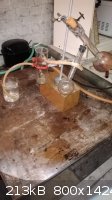
a 250ml retort is fitted with a cork so that the outlet tube leads into the top of another retort of which the outlet tube is pointing up. that tube
is connected by a hose to a suckback trap to a beaker of cold water.
the other retort is placed in cold water.
the retort with RP is then heated so that a constant stream of vapor goes into the other retort and condenses
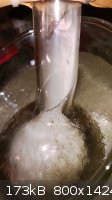
after a while liquid P4 will start coming over.
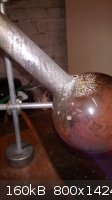
refluxing P4
observations:
-loading the retort over 50% full is not recommended
-Later the rubber stopper was replaced with a well greased NS19 stopper.
-notice I used my crappiest table, in case of an accident
-a bucket of cat litter should be on hand
all above information is intellectual property of Pyro.  |
|
|
Bert
Super Administrator
        
Posts: 2821
Registered: 12-3-2004
Member Is Offline
Mood: " I think we are all going to die. I think that love is an illusion. We are flawed, my darling".
|
|
Red to white is cool, how 'bout white to red?
In freshman year highschool chemistry, my teacher let us try to convert white Phosphorus to red- One of those wonderful labs where the book did not
QUITE prepare you for what was really going to happen.
Procedure was to cut off a "pea sized" lump of white P from the stick under water and quickly put it in a test tube, heat it in a beaker of hot water.
It oxidized, did not burn much before the O2 was used up and it smothered the fire. All OK so far... The hood was handling it, barely even smelled
anything.
We MIGHT have used a little more P than we were supposed to have. Like 2 to 3 X. Teacher noticed... Did not stop us, but suggested we close the hood
pretty much all the way for the next step, and put a long high temp glove on the arm one of us was going to stick in there under the door for the next
step. Then he went to the other side of the room? Why did he do that, I wondered.
We did as the lab book said, took a long handled stainless steel tool and carefully dropped a little crystal of Iodine into the tube of melted white
P. The Iodine was SUPPOSED to help it polymerize into red P as it slowly cooled? Oh yes, we were also supposed to put a stopper in there, to keep O2
from getting in? But we didn't get that far.
KABLAAAM!
Took quite a while for us to clean up the broken glass, spilled water/weak phosphoric acid and all those little smoky bits in the hood. Learned about
explosive effects in an incompressible medium, uses of Copper sulfate, etc. And we also learned that day, that an experiment going as planned is good,
but one NOT turning out as expected can be F*&@ing GREAT!
Rapopart’s Rules for critical commentary:
1. Attempt to re-express your target’s position so clearly, vividly and fairly that your target says: “Thanks, I wish I’d thought of putting it
that way.”
2. List any points of agreement (especially if they are not matters of general or widespread agreement).
3. Mention anything you have learned from your target.
4. Only then are you permitted to say so much as a word of rebuttal or criticism.
Anatol Rapoport was a Russian-born American mathematical psychologist (1911-2007).
|
|
|
Marvin
National Hazard
   
Posts: 995
Registered: 13-10-2002
Member Is Offline
Mood: No Mood
|
|
Envy, envy envy.
I tried to get my school chemistry teacher to demonstrate white P when I was 12 or 13, "I'm not giving you any, you know" but no joy, couldn't even
find a local school that had any. He transferred out at the end of that school year for a deputy head job and we lost our best chemistry teacher.
Maybe we'd be shown it for A levels. No. We had a proper chemistry teacher for A levels again (we were bussed to another school) but no phosphorous.
Still, I was sure I'd get to use it at degree level, I mean I went to one of the highest ranked chemistry departments in the country....
No. Not even final year, never used it, even shown it, never demonstrated as part of the degree. The closest to white P I've ever been was one of
those visiting lectures done just for fun ignited some in an oxygen filled flask, but it was all pre prepared so all you saw was a cloud of glowy
oxide.
My dad on the other hand, now sadly not with us, as a teenager used to squash pieces of the waxy white phosphorous into an air rifle and fire it at
the chimney pot and he said he tried writing his name on the wall paper once so he could see it glowing in the dark. When it stopped glowing and he
put the light on there was a scorch mark on the wall.
|
|
|
careysub
International Hazard
    
Posts: 1339
Registered: 4-8-2014
Location: Coastal Sage Scrub Biome
Member Is Offline
Mood: Lowest quantum state
|
|
I am planning on conducting this experiment, making WP for my element collection, and have acquired the materials to put it together, but given the
dangerous nature of this material I would like to describe my proposed set-up for criticism.
I have a 250 mL alembic-style borosilicate retort for the distillation (which will be less than half full according to Pyro's guidance) which will be
heated by a PID controlled heating mantle for gradual heating. The experiment will be done outside on a concrete patio. I will use Krytox grease on
the stopper.
Now my plan for collection is to simply immerse the end of the alembic-retort in a container of water kept at 50 C or so (above the 44 C melting point
of WP) so that it flows to the bottom of the collection flask, and there is no risk of clogging.
Is the 230 C temperature differential across the retort too great for safety? I could use hotter water, say 90 C, to reduce the differential to 190 C
if it would help.
I would first try to distill some triethylene glycol (BP 285 C) to test the apparatus to see that it withstands the heating regimen, but I'd rather
not break the retort so if the procedure is unlikely to work I would not bother.
I have a back up plan of sweat-soldering together a copper retort out of copper pipe fittings which I know will not break under this procedure. Some
of the phosphorus would react with the copper to make copper phosphide, but it sounds like it might form an effective protective coating (since the
copper sulfate treatment depends on that happening).
I like the simplicity of having the collection done directly under water hot enough to melt the WP, it seems like an inherently safer procedure with
no chance of clogging or air contact.
About that which we cannot speak, we must remain silent.
-Wittgenstein
Some things can never be spoken
Some things cannot be pronounced
That word does not exist in any language
It will never be uttered by a human mouth
- The Talking Heads
|
|
|
Magpie
lab constructor
    
Posts: 5939
Registered: 1-11-2003
Location: USA
Member Is Offline
Mood: Chemistry: the subtle science.
|
|
What's the ID of the outlet?
You might get some deposits in the "condenser" part of the alembic if its temperature drops below the mp of P. You could always wrap it with a
heating coil if necessary.
The single most important condition for a successful synthesis is good mixing - Nicodem
|
|
|
careysub
International Hazard
    
Posts: 1339
Registered: 4-8-2014
Location: Coastal Sage Scrub Biome
Member Is Offline
Mood: Lowest quantum state
|
|
Quote: Originally posted by Magpie  | What's the ID of the outlet?
You might get some deposits in the "condenser" part of the alembic if its temperature drops below the mp of P. You could always wrap it with a
heating coil if necessary.
|
I was prepared to insulate the alembic tube to keep that from happening.
I suspect insulation alone should suffice to ensure this given that both ends of the alembic are kept above that temperature.
My main concern was the temperature differential across the glass, from 280 C or so ~50 C would be greater than even borosilicate can handle.
About that which we cannot speak, we must remain silent.
-Wittgenstein
Some things can never be spoken
Some things cannot be pronounced
That word does not exist in any language
It will never be uttered by a human mouth
- The Talking Heads
|
|
|
| Pages:
1
2 |